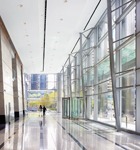In the past five years, building design has evolved to incorporate more sustainable practices and elements than ever before, and many existing properties are being renovated to take advantage of green innovations that significantly reduce energy- and water-usage costs and minimize the structures’ impact on the environment. But while many organizations can achieve a level of success simply by reacting prudently to industry shifts or market fluctuations, becoming an industry leader takes something special: intelligence. Oxford Properties Group, a commercial-real-estate firm based in Toronto, employs what it calls the Sustainable Intelligence program to properly integrate sustainability strategies with its business plan and ensure they’ll work over the long term.
What does sustainability mean to the people at Oxford Properties? Speaking candidly, senior vice president and managing director Andrew McAllan says, “I believe governments, businesses, and individuals have to rise above short-term pressures and make difficult choices so that we leave a world for our children that has not reached the tipping point in terms of climate change, resource depletion, and pollution.”
Through its Sustainable Intelligence program, the company identifies opportunities for green development within its property portfolio while also making the financial case to its stakeholders for taking advantage of such opportunities. Incredibly, the program has enjoyed success ahead of schedule, meeting its goal of a 20 percent reduction in total emissions before its 2012 deadline. In response, the firm is now working on an additional 10 percent reduction by 2014. “Oxford is proud to have been the first in our industry to set a target,” McAllan says, “and we remain the only landlord to have a transparent, portfolio-wide energy-reduction target.”

Illustrating Oxford’s shrewd sustainability initiatives, upgrades to Toronto’s Royal Bank Plaza resulted in $1.8 million in energy savings for the building’s tenants.
Standing out in that portfolio are Centennial Place and Royal Bank Plaza, particularly stunning developments that showcase disparate but equally striking achievements in sustainability. Centennial Place, a pair of skyscrapers in Calgary, Alberta, were built and are managed by Oxford Properties and opened last year after being designed and constructed to LEED Core & Shell Gold standards. There, the company instituted a groundbreaking zero-waste recycling program that accommodates both office towers and the tenant and public sides of the food court. Going further than traditional recycling programs, the zero-waste initiative involves gathering electronics, batteries, toner cartridges, and organic material. Even wasted oil from the food court is collected and used in manufacturing biofuel.
During construction, several green practices were implemented: one-fifth of the new materials were composed of recycled content, including the structural steel, ceiling tiles, and aluminum curtain walls; 81 percent of all the wood purchased for the project was harvested in accordance with FSC standards; and 59 percent (or, 5,830 tons) of the base building waste was diverted from landfills and reused or recycled. Other green features have a tangible impact on the structure’s bottom line: low-flow showers, half-flush urinals, and ultra-low-flow faucets with automatic controls reduce water usage by 35 percent, and high-efficiency lighting, occupancy sensors, and an advanced metering system further reduce energy costs by 40 percent. McAllan says these achievements reflect the organization’s values. “I believe that companies who build green into their organizational DNA—both their principles and competencies—are better positioned to serve their customers and be more profitable over the long term,” he says.
In Toronto, the company’s renovation of the Royal Bank Plaza necessitated a different sustainable approach. Rather than designing a building from scratch, Oxford Properties retrofitted the existing property with a recycling program and upgrades that increased cost-effectiveness by reducing energy and water usage. Included in the updates were energy-efficient lighting and improvements to the air-distribution system. Rainwater collection tanks were also installed to provide irrigation, eliminating the use of municipal water for landscaping. And the building’s recycling program now diverts more than 70 percent of its waste away from landfills. “The result of these upgrades has been a 25 percent reduction in electricity, 48 percent reduction in steam, and a 43 percent reduction in chilled water,” McAllan says. “In 2010 alone, we saved our tenants over $1.8 million in energy costs.”
McAllan says that tenants often choose Oxford Properties buildings specifically because of the LEED features, reinforcing the fact that what’s good for the environment is good for business. “Sustainability is challenging the status quo in our sector and driving new ways of doing things,” McAllan says. “That’s what we’re trying to do at Oxford. We are committed to sustainability and know that this will contribute to our company’s success going forward.”

